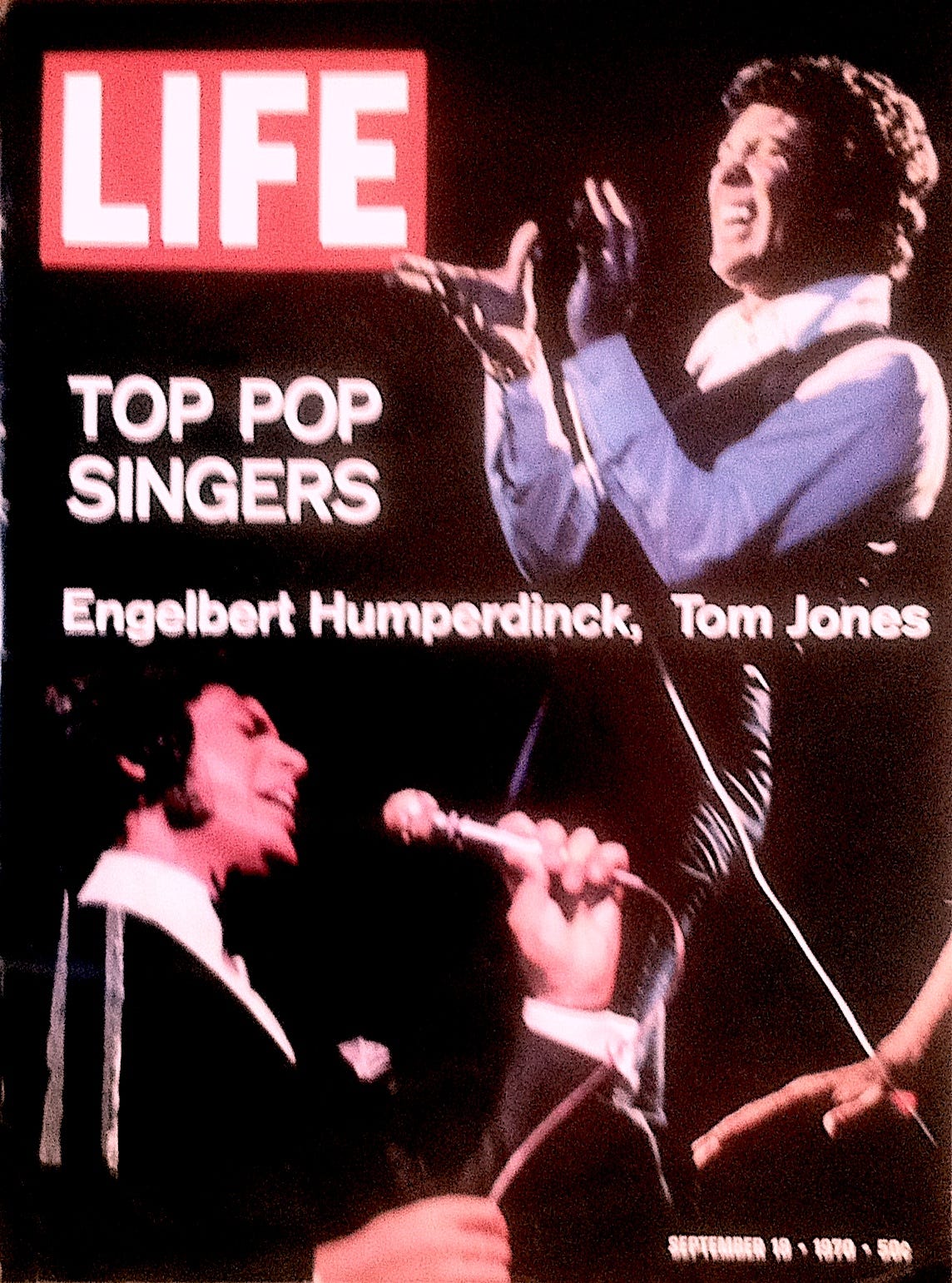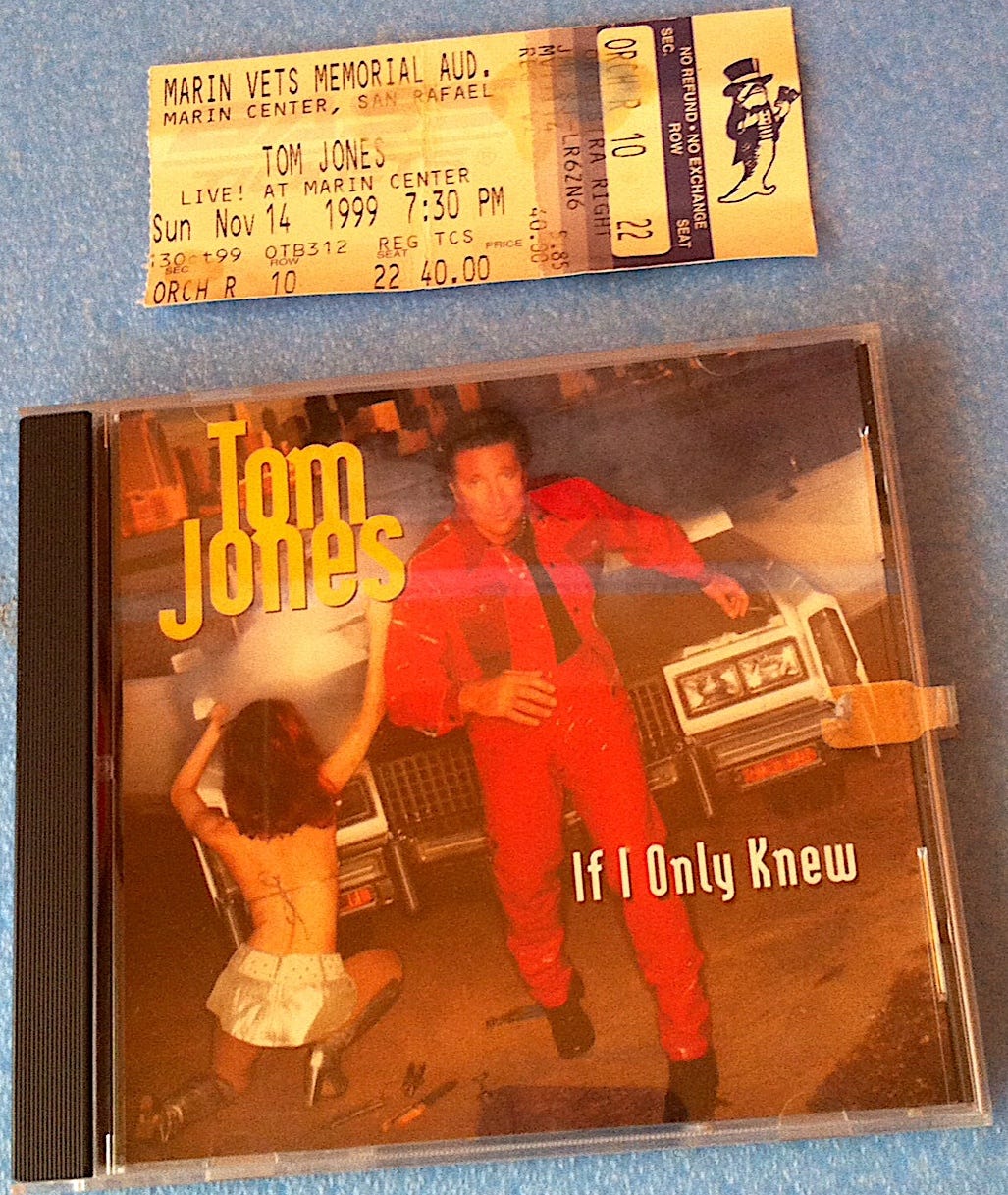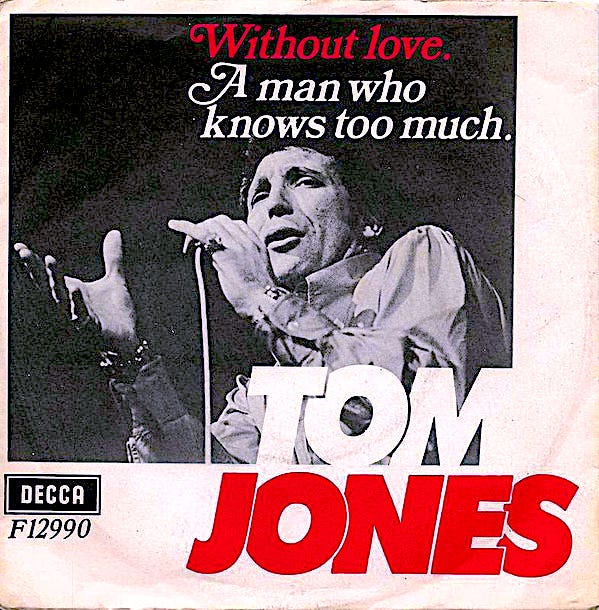Happy Birthday to Sir Tom Jones: When I was a kid in the 1960s, I didn’t “get” Tom Jones. To me he was some dopey hunk who riled up my Mom and my aunts when he belted tunes on the boob tube.
I usually fled the room (though I stuck around when he had hipster guests like Julie Driscoll with Brian Auger & The Trinity). Years passed. My juvenile opinions wore off and my musical vocabulary grew to better appreciate great artists. I became an ardent fan of Tom Jones, one of the yardsticks by which great singers are measured.
In 1999 I was writing music articles for the Sun-Gazette newspaper in the Pennsylvania city of Williamsport. Tom Jones was coming to town and I blasted out a 2000 word promotional article (edited and updated below). Someone decided I should hand a copy to Tom when he landed in town. I was told he rarely does “meet and greets,” and I was issued a top secret backstage pass with three other privileged souls. Our chat was short but warm. I gushed a bit about how I’d “rediscovered” him and how I connected with his newer material. He appreaciated that and said he’d be doing those songs with the hits everyone wants to hear. For a guy with such a huge singing voice, he spoke in a quiet rumble. He also told me to say hello to “that other Jones,” meaning Davy Jones (who I was working with at the time). I rarely ask for autographs, but Tom signed my LEAD & HOW TO SWING IT CD and accepted my article, saying he’d read it later. Then I got out and let him do his show, which was as brilliant as I expected.
Edited/updated article from March 1999: He has has been a bricklayer, a cartoon character, a rebellious “Teddy Boy” and a working class hero—but in his native Wales, and throughout the music world, he is known as “Jones the Voice.” When an announcer proclaims, “this is Tom Jones,” it is usually followed by thunderous appluause. On stage he picks from an extensive catalogue of hits, packaged in a spectacular stage show. His unique vocal power, which traverses from a weighty baritone to a growly tenor, is still popular after six decades. One of the most charismatic and enduring personalities in show business, his recordings have covered the spectrum from blues to country, from gospel to pop/rock, from standards to techno/dance.
First and foremost, Jones is a rocker with a rhythm and blues soul. During his youth, he sang in the church and his school choir, but his style and attitude was dominated by the early years of rock’n’roll. Immersing himself with the radio and hanging around in pubs, he discovered he could sing anything and entertain any audience. Born the son of a coal miner in 1940, his heritage plays prominently in his story—the Welsh/Celtic traditions of poetry and work songs are recurrent themes in Jones’ choice of material.
At age 17 Jones married and had his first son. To support his new family he worked through physically demanding “day jobs” while playing drums and singing in bands at night. By 1963, after many gigs in the demanding atmosphere of working-class dance halls, Jones was building a following with his group Tommy Scott & the Senators. It was during this stint that Jones was discovered by manager/producer Gordon Mills, who had written songs for British hitmakers Johnny Kidd and Cliff Richard. Mills became convinced that Jones had “a voice that could make him the greatest singer in the world.”
Mills brought Jones to London to promote him, and they were met with resistance. Jones was told that his voice was “too raucous and powerful” and that he sounded “too black and moved like Presley.” His performance style was “too forward and sexual.” However, the two men persisted and landed a contract with Decca/Parrot Records in 1964. It was Jones’ second single, a song written by Mills called It’s Not Unusual, which became a smash international hit. BBC radio, meanwhile, wouldn’t play the record (it was “too hot”) so it was broken to the listening public by the legendary off-shore pirate radio station Radio Caroline. The full-length album contained a Scottish lullaby, a Johnny Mercer tune, and r’n’b covers by Jones’ mentors: Brook Benton, The Drifters, Wilson Pickett and others.
Following tours as an opening act for headliners such as The Rolling Stones, Jones’ career took root. A string of hit singles followed: Never Fall in Love Again, Without Love and Green Green Grass of Home—which was initially submitted to, and rejected by Elvis Presley (he cheered when Jones had the hit). The waltz-like Delilah and What’s New Pussycat have become “lounge standards,” extolling the fun of British machismo and late 60’s Carnaby Street fashionability.
By the end of 1970 Jones had sold over 30 million discs in all categories world wide. From 1966 and into the early 1970s his albums and singles were in Top 10 charts in both Europe and the United States. His concert albums (TOM JONES LIVE, IN LAS VEGAS, AT CAESER’S PALACE) have sold particularly well by capturing his “live energy” while not forsaking his “working man” and r’n’b roots.
Jones’ ever increasing skills as a singer and his on-stage combustability made him a favorite of critics and audiences alike, but drawing capacity crowds around the world was not enough. The next conquest for Jones was television. His short running but highly acclaimed 1969 TV series established Jones’ place in the heart of middle America. A contract was drawn with ABC that, at the time, was the largest ever between network and artist. Location’s for the show were split between London and Los Angeles, and Jones used the show as a platform for an impressive array of new talent and guest artists (see accompanying article). Jones’ “Welshness” was an ongoing reference in the show—which even featured a Welsh choir.
During the 1970’s Jones focused less on recording and more on business and family. While no longer at the forefront of Top 40, his solid drawing power as a concert act and showman remained steady and his body of hit records were still in demand.
Re‑entry of “new Tom Jones” material on the airwaves occured in 1987. Jones was asked to perform in a musical called MATADOR for the CBS/Epic label. The single, A Boy from Nowhere, reached number two on the British charts. A re‑release of It’s Not Unusual in London dance clubs sparked a new fan base for Tom Jones. The next victory was the sensational techno/pop cover of Prince’s Kiss, putting Jones back on the international charts. The video of Kiss was seen in strong rotation on MTV and VH1, winning the “Breakthrough Video” MTV award in 1988. Jones proved that he could reach across all demographics—it became “cool” to be a Tom Jones fan all over again.
He reignited his recording career with the 1991 album, CARRYING THE TORCH. Old friend Van Morrison composed, performed on and produced four songs, recorded live in the studio with Morrison’s band in one afternoon. The Jones/Morrison team went on to work with seminal Irish group, The Chieftains, on the mega‑collaboration album, THE LONG BLACK VEIL. The critically lauded 1994 album features Jones giving a full-voiced Celtic treatment of The Tennessee Waltz. In the same year Jones signed with upstart label Interscope Records. The hottest producers in the business—including Flood, Trevor Horn, Jimmy Iovine, Jeff Lynne and Youth—clamored for the opportunity to interpret Jones’ artistry in the studio. The result was one of Jones’ crowning achievements. Critics fell over THE LEAD AND HOW TO SWING IT—a marvelous expose of cutting-edged Euro‑pop, gospel, r’n’b and techno.
Musically backed by Sting and members of Pink Floyd, Jones was invited to perform at a series of high profile events—including the 30th Anniversary of Amnesty International. As a “special guest” at the Glastonbury Festival of Contemporary Performing Arts in 1992, Jones “stunned” an audience of 75,000, giving “the watershed performance of his latter career.”
The motion picture industry utilizes Jones as soundtrack and “cultural reference material” (AUSTIN POWERS, THE FULL MONTY). In 1996 Jones worked in his first feature film, MARS ATTACK, with director Tim Burton. In this sci‑fi spoof, Jones saves a group of earthlings after being interrupted in the middle of a concert.
Contrary to his “sex symbol” image, Jones claimed to be a monogamous “family man,” proud of his long term marraige to Melinda (who passed away). In the spirit of “keeping it in the family,” Jones is managed by his son, Mark Woodward, who traveled with his father since the age of 17.
FIVE REASONS WHY TOM JONES IS A TRUE ARTIST
There’s no disputing Jones’ power as an entertainer and singer, but is it art? His global fan base will enthuse about his vocal muscle and sex appeal. To a degree, his bankability was built on a campy image—the open-shirted “he man” dynamo belting out She’s a Lady to mesmerized throngs of overheated “borscht belt” citizenry. Admittedly, Jones’ routine reliance on “middle class production values” and his entrenchment in the Las Vegas circuit has caused some to dismiss Jones as retro‑passive entertainment, unfairly equating him with the soft pop expressions of Engelbert Humperdink (who also happens to be Welsh). Upon further study, however, Jones rises above the charge of being mere “ballroom schmaltz.” A review of Jones’ history reveals that he takes serious care with his craft and “artistic challenge” is part of his quest:
1) Jones is a champion of the collaboration, evidenced by the roster of his television shows and choice of material for his recordings. Jones’ ongoing interest in the merger of talent and style became particularly apparent in 1988, when self-described “avant-garde pop group” The Art of Noise requested that Jones sing on the smash hit cover of Prince’s Kiss. A similar effect occured in 1993 when Jones’ recorded with alternative rock band New Model Army on a version of The Rolling Stones’ classic Gimme Shelter. In 1991, punk rock impresario Malcolm McLaren cast Jones alongside Kirsty MacColl, Sinead O’Connor and The Pogues to perform in the Christmas production THE GHOSTS OF OXFORD STREET, produced by Dave Stewart (Eurythmics). In 1992, Jones ran the gamut from the cartoon appearance on THE SIMPSONS to a live stage performance of Dylan Thomas’ UNDER MILWOOD, directed by Sir Anthony Hopkins and performed in the presence of The Queen of England. His collaborations with The Chieftains and Van Morrison have underlined the trend of merging Celtic/American roots with contemporary music. The matrix of producers on THE LEAD AND HOW TO SWING IT demonstrated a technology-driven exploration of Jones’ personal culture.
(covering a Jeff Lynne song)
2) The 1969 ABC television series, THIS IS TOM JONES, was probably the hippest variety show ever. Not only did he break obscure British comics and unknown music acts (Brian Auger & the Trinity, Mary Hopkin) to American audiences, his guest list of musicians read like a “who’s who” of popular music: Burt Bacharach, Tony Bennett, Johnny Cash, Ray Charles, Crosby Stills Nash & Young, Ella Fitzgerald, Janis Joplin, Jerry Lee Lewis (one of Jones’ heroes), Joni Mitchell, Motown stars and dozens more. Reruns contain rare TV appearances by Anne Bancroft and Kirk Douglas—as well as “very young” footage of The Bee Gees, Joe Cocker and Richard Pryor. The show was reprised in 1992 when he launched the six-part series, TOM JONES: THE RIGHT TIME. Totally music-based and designed in a way unique to television formats, his interesting blend of guests artists included EMF, Al Jarreau, Cyndi Lauper, Lyle Lovett and others. The series aired in the U.S. on VH‑1.
3) Jones hires only top-notch musicians. A “rising young session guitarist” named Jimmy Page found journeyman employment on Jones’ mid‑60s sessions. In the formative years of 1964‑65, his back‑up band was The Spencer Davis Group, who eventually had hits when group member Stevie Winwood found his voice. In an early promotional biography, Jones cites Otis Redding as one of his influences, suggesting that Jones’ would be an integral member in the British society of appreciating American roots music.
4) As sort of a return compliment, Elvis Presley would sing Delilah to warm up his voice for concerts. A friend and contemporary of Jones, Presley initially passed on recording Green Green Grass of Home, which went on to become a huge hit for Jones in 1966. Presley was so impressed by Jones’ record, he hounded radio stations to play it repeatedly. Eventually Presley recorded his own version and made it a frequent title on his concert set list.
5) A clever flair for musical juxtaposition is one of Jones’ signatures. On a typical TJ album “it’s not unusual” to hear a Broadway showtune, a Celtic folk song or a country standard translated through a production mix of Euro‑pop clarity and Nashville/Memphis earthiness. Without being contrived or derivative, Jones will spin off a jazz arrangement of Sixteen Tons, a TexMex-flavored moral tale in A Young New Mexican Puppeteer, or a pumped up contemporary gospel message in I Don’t Think So:
Jones still maintains an international touring schedule and is a frequent participant in charitable causes. His voice has matured and seasoned. His driving performances and charming personality still touches people everywhere. he has made his niche out of a singular devotion to his craft as an entertainer— an honorable balance of reaching out to the “working classes” while staying on the edge as as artist.
END
#tomjones #singer #johnnyjblair #birthday











